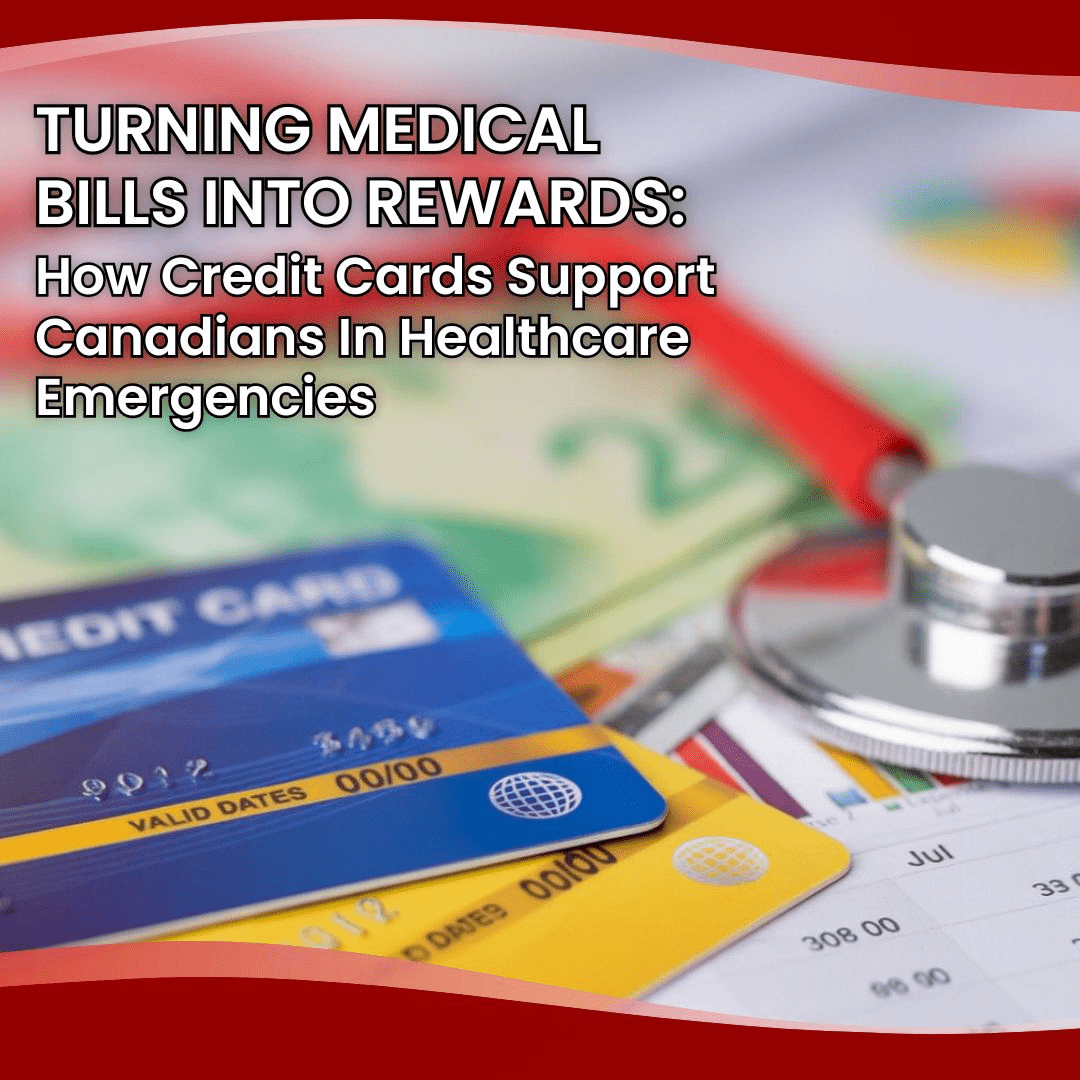Picture this: Emily, a 29-year-old marketing professional in Vancouver, walks out of her dentist’s office after a root canal. The bill? $1,200. Her workplace benefits cover half, but she still owes $600 on the spot. Instead of draining her chequing account, she hands over her Amex Cobalt Card. By the time her statement arrives, she’s earned points redeemable toward groceries and travel—on a bill she had to pay anyway.
This is no longer unusual. Canadians are facing more out-of-pocket healthcare costs than ever. According to the Canadian Institute for Health Information (CIHI), households collectively spend billions annually on services outside the scope of public healthcare. From dental checkups to physiotherapy, psychotherapy, and vision care, healthcare spending is hitting wallets hard. And increasingly, Canadians are turning to credit cards not out of necessity, but as a deliberate strategy.
The question is no longer “Should I use a credit card at the clinic?” but “Which credit card will make this $200 physiotherapy bill work hardest for me?”
In this article, we’ll dive deep into how credit cards for healthcare in Canada are reshaping the way households manage medical costs, maximize rewards, and prepare for financial uncertainty.
Why Healthcare and Credit Cards Are Colliding
Rising Out-of-Pocket Costs
While Canadians value universal healthcare, its limitations are clear. Dental, vision, prescription drugs, mental health counselling, and alternative therapies often fall outside coverage. For many, this means hundreds or thousands of dollars in expenses each year.
For seniors on fixed incomes, students with minimal benefits, or self-employed Canadians without workplace plans, these costs can feel overwhelming. The ability to manage them with a rewards credit card transforms a necessary burden into an opportunity.
The Convenience of Modern Payment Systems
From independent psychologists to physiotherapy chains, most healthcare providers now accept Visa, Mastercard, and American Express. Some even encourage card payments to streamline billing. That acceptance opens the door for consumers to integrate healthcare spending into their rewards strategies.
Rewards Potential: Turning Health into Wealth
The real shift lies in mindset. Canadians are no longer seeing credit cards as debt traps, but as financial tools. By putting essential healthcare expenses on cards like the TD Cash Back Visa or Tangerine Credit Card Cash Back, families can offset costs through rewards, cash back, or even travel redemptions.
Where Canadians Are Using Credit Cards for Healthcare
1. Dental Clinics
Annual checkups, fillings, braces, and implants are some of the largest recurring out-of-pocket expenses. A family of four can easily spend over $2,000 annually on dental care. Putting those expenses on top-rated cash back credit cards can yield hundreds back each year.
2. Prescriptions
Pharmacies like Shoppers Drug Mart, Rexall, and Costco almost always accept credit cards. Pairing recurring drug costs with a Tangerine Credit Card Cash Back (where pharmacy is a chosen category) or the Amex Gold Rewards Card ensures prescriptions contribute to rewards earnings.
3. Therapy and Mental Health
From psychotherapy to registered massage therapy (RMT), Canadians are investing heavily in wellness. With sessions costing $120–$200 each, putting them on a rewards card can generate consistent returns. Younger Canadians often prefer the Amex Cobalt Card, given its accelerated earn on recurring services.
4. Physiotherapy and Rehabilitation
Sports injuries, chronic back pain, or post-surgery rehab quickly add up. Since physiotherapists widely accept credit cards, using the Amex Gold Rewards Card or TD First Class Travel allows patients to not only heal but also earn meaningful points.
5. Private Medical Clinics
Private imaging centres, specialists, or virtual health services often come with high costs. Cards like the Amex Business Platinum Card(for entrepreneurs paying for private coverage or employee benefits) add value through travel insurance and flexible redemption options.

Case Study: Healthcare Spending by the Numbers
Let’s break down a realistic example.
- Monthly prescription drugs: $120
- Dental cleanings and fillings (annual): $1,200
- Therapy (bi-weekly): $4,800/year
- Physiotherapy package (10 sessions): $900
- Vision care (glasses & exam): $400 every two years
Annual spend: ~$7,400
Put on the Amex Cobalt Card, this could translate into over $250 in rewards value. On the TD Cash Back Visa, that same spend nets predictable statement credits. For families managing multiple health categories, the rewards potential becomes even more significant.
Spotlight: Best Credit Cards for Healthcare in Canada
Amex Cobalt Card
- Perfect for recurring healthcare payments.
- Earns strong rewards on everyday essentials, making it versatile beyond clinics.
- Great for younger Canadians balancing health with lifestyle.
TD Cash Back Visa
- Simple, flat-rate cash back.
- Ideal for retirees and families seeking straightforward value.
- Rewards apply directly to the statement—no complex redemptions.
Amex Gold Rewards Card
- Accelerated rewards at pharmacies.
- Travel insurance that aligns with broader healthcare needs while abroad.
- Excellent middle-tier card for professionals.
Tangerine Credit Card Cash Back
- Customizable categories make pharmacy an earning powerhouse.
- Great for households with monthly prescriptions.
Amex Business Platinum Card
- High annual fee, but premium rewards.
- Valuable for entrepreneurs funding employee healthcare or private coverage.
- Caveat: business cards lack consumer protections under Canadian law.
Beyond Rewards: The Hidden Benefits
Tax Efficiency
Tracking healthcare spending is painful—unless you put it all on one card. Credit card statements provide a built-in log, simplifying claims for the medical expense tax credit.
Emergency Flexibility
A private MRI or urgent dental procedure can cost thousands. Even if you plan to pay in full, using a credit card offers short-term float and fraud protections.
Budget Clarity
Healthcare can feel “invisible” compared to groceries or rent. Dedicating one card to medical costs highlights exactly what you’re spending and where.
Pitfalls to Watch For
Carrying Balances
Interest rates of 19–24% wipe out any rewards earned. Canadians must pay in full monthly for this strategy to work.
Overestimating Reward Value
A $100 annual fee card must generate at least $150 in benefits to be worthwhile. Otherwise, stick with no-fee options like the Tangerine Credit Card Cash Back.
Business Card Risks
While the Amex Business Platinum Card offers incredible perks, remember that business cards lack the same protections as consumer cards in Canada.
Real Canadian Voices
- Claire, 42, Toronto: “I started using my Amex Gold Rewards Card for prescriptions. It feels like I’m finally getting rewarded for something I can’t avoid paying.”
- Raj, 65, Vancouver: “On a fixed pension, I use the TD Cash Back Visa for dental bills. Simple, predictable rewards keep me sane.”
- Emma, 25, Montréal: “As a student paying for therapy, my Amex Cobalt Card makes it less painful financially. It’s part of my self-care plan.”
The Bigger Picture: Financial Wellness Meets Physical Wellness
When most Canadians think of credit cards for healthcare in Canada, the first thought is usually about rewards: How much cash back can I get on prescriptions? Which points system gives me the most value at the dentist? While those are valid and practical considerations, the real story goes much deeper. This shift in how Canadians pay for healthcare is part of a much larger cultural and financial movement—one where financial wellness and physical wellness have become inseparable.
At its core, healthcare spending is not optional. Whether it’s an annual dental cleaning, physiotherapy after an injury, or counselling sessions to maintain mental health, these costs inevitably arise. Traditionally, they were treated as frustrating out-of-pocket expenses that drained bank accounts with little to no upside. Now, with the right credit card strategy, Canadians are transforming those same unavoidable expenses into opportunities to reinforce their financial stability.
Reducing Stress Through Rewards
Healthcare costs can be one of the most stressful categories of personal spending, especially for retirees on fixed incomes or young professionals without comprehensive benefits. When a $400 physiotherapy bill lands, it can feel like a setback. But when that same bill earns $12 in cash back through a TD Cash Back Visa or helps build toward free groceries with an Amex Cobalt Card, the psychological impact shifts. Instead of pure expense, it becomes an investment with a return.
The stress reduction here is subtle but powerful. When Canadians feel their healthcare spending is working for them, they experience less resentment and anxiety about the cost of staying healthy. That sense of control contributes to better overall wellness.
Linking Health Goals to Financial Goals
Financial wellness and physical wellness often share a feedback loop. For example, someone attending regular physiotherapy sessions may prevent a more serious injury that would otherwise lead to lost work and higher expenses. By using a credit card with strong cash back or points rewards, they not only protect their body but also accumulate financial perks.
It’s the same with preventative care. Routine eye exams, dental visits, or counselling sessions might be expensive upfront, but they protect long-term health. By integrating these costs into a rewards strategy, Canadians are essentially “double-investing”—once in their health, and once in their financial future.
Better Tracking for Better Decisions
Another underrated benefit of paying for healthcare with credit cards is the detailed tracking. Monthly statements act as a built-in log of expenses, which is invaluable during tax season when Canadians claim medical expense tax credits. Instead of scrambling for receipts from five different clinics, all the data is neatly organized in one place.
This transparency also allows households to evaluate their health priorities. If a couple notices that $3,000 a year is going to dental work but almost nothing toward mental health services, they can reassess where their money—and their attention—should go.
Checklist: How to Use Credit Cards for Healthcare Wisely
For this synergy between financial wellness and physical wellness to work, Canadians need to approach it with a strategy. Here’s a practical checklist:
1. Choose the right card for your healthcare spending pattern.
If prescriptions dominate your spending, the Amex Gold Rewards Card with its pharmacy benefits might be ideal. If you want simplicity, the Tangerine Credit Card Cash Back with customizable categories is a winner.
2. Funnel all medical costs through one dedicated card.
By centralizing, you maximize rewards and make tracking taxes effortless.
3. Always pay balances in full.
This strategy collapses if interest charges outweigh your rewards. Paying in full ensures you reap benefits without creating debt stress.
4. Track spending for taxes.
Healthcare spending often qualifies for credits, and your card statements simplify claims.
5. Reevaluate annually.
Healthcare needs change. The right card for you this year may not be the best fit next year. Review your habits regularly.
A New Lens on Healthcare Spending
What’s emerging in Canada is a cultural shift. Healthcare is no longer just a financial obligation; it’s becoming part of a rewards-earning lifestyle strategy. Canadians are proving that financial wellness isn’t about penny-pinching—it’s about using tools like credit cards to make essential spending smarter. And when that essential spending is tied directly to physical well-being, the impact multiplies.
The synergy is clear: by blending financial optimization with personal health, Canadians aren’t just saving money. They’re rewriting what it means to live well in the modern era.
Conclusion: From Burden to Advantage
Healthcare costs aren’t going anywhere. But Canadians are proving that with smart strategies, out-of-pocket expenses can transform from financial burdens into opportunities. By aligning dental, therapy, and prescription spending with rewards programs, households can reclaim hundreds of dollars annually—all while staying healthy.
So the next time you swipe your card at the pharmacy or dentist, remember: it’s not just a transaction, it’s a strategy.
Start turning your healthcare bills into rewards today. Apply for your next card through Great Canadian Rebates and unlock exclusive cash back offers.


